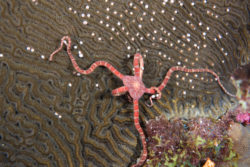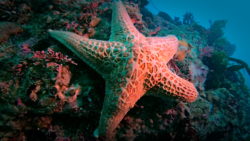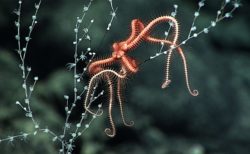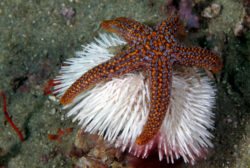
What’s the Difference? Brittle Stars vs. Sea Stars
You wouldn’t be alone in thinking sea stars and brittle stars are one in the same. They look awfully similar and are closely related, but they are actually quite different. Despite both being marine invertebrates within the same phylum Echinodermata, they have unique characteristics that make them distinct, lovable creatures of the sea. Learn about what traits these shining stars share and what makes them perfectly different below:

A ruby brittle star snags a few gametes before they can get away during the corl spawning season in Flower Garden Banks National Marine Sanctuary. Photo: G.P. Schmahl/NOAA
Brittle Stars
Within the phylum Echinodermata, brittle stars are in the class Ophiurodiea.
Brittle stars can be easily distinguished from sea stars by their bodies. Brittle stars’ arms connect to a central disk on their body. This central disc contains a calcium carbonate skeleton and all of their internal organs. It is also a key part of their ability to regrow their arms.
They have skinnier and longer arms that are flexible and solid. Their arms can each grow to be 24 inches long. It is clear where their arms begin and end and where their central disk is.
Brittle stars do not use their water-based vascular system to move. Instead, they twist and bend their long arms to move which allows them to move more quickly than sea stars.
They are seafloor ecosystem engineers, named for their role in reshaping sediment on the seafloor when they twist and coil their arms to move.

A sea star in Monterey Bay National Marine Sanctuary. Photo: Eric Wahl
Sea Stars
Within the phylum Echinodermata, sea stars are in the class Asteroidea.
Unlike brittle stars, sea stars lack a central part of the body. Instead, their arms connect at a single point that is central on their body.
Sea stars have thicker and more triangular arms which merge together at the center.
Sea stars rely on their water-based vascular system to propel water and help them move. This system involves the use of tube feet which supports locomotion, adhesion, sensory detection, food capture, and respiration.
All of their vital organs are located in the arms, not the central disk like the brittle star. Most species of sea stars have five arms, but some have many more—even as many as 40.

A brittle star climbing on a octocoral skeleton in National Marine Sanctuary of American Samoa. Photo: NOAA Office of Ocean Exploration and Research, 2017 American Samoa

Sea star sits atop an urchin in Gray’s Reef National Marine Sanctuary. Photo Credit: Greg McFall/NOAA
Brittle Stars and Sea Stars
Sea stars and brittle stars are related which is why they have a lot of similarities. They are both in the phylum Echinodermata which also includes sea urchins, sea cucumbers, sand dollars and more.
Both have a tough, spiny surface which is how their name came about — echino means spiny and derma means skin in Greek.
They are both colorful invertebrates with an average of five arms. Echinoderms have a five-point radial symmetry with nearly equal arms arranged in a circle.
They each have a unique water vascular system which brings liquid throughout their body using organs called tube feet.
Both can regrow body parts if they are broken off or eaten!
They both occupy nearly all areas of the world’s ocean and most of our national marine sanctuaries – Flower Garden Banks, Monterey Bay, and Olympic Coast to name a few.
They both represent nearly 2,000 species.
Mystery solved! While they both have that star-quality, brittle stars and sea stars are quite different. Next time you’re exploring, you can tell the difference between these two invertebrates by their body shape, arms, and the way they move! If you want to dive even deeper into brittle stars, check out “Sea Wonder: Brittle Stars.”
